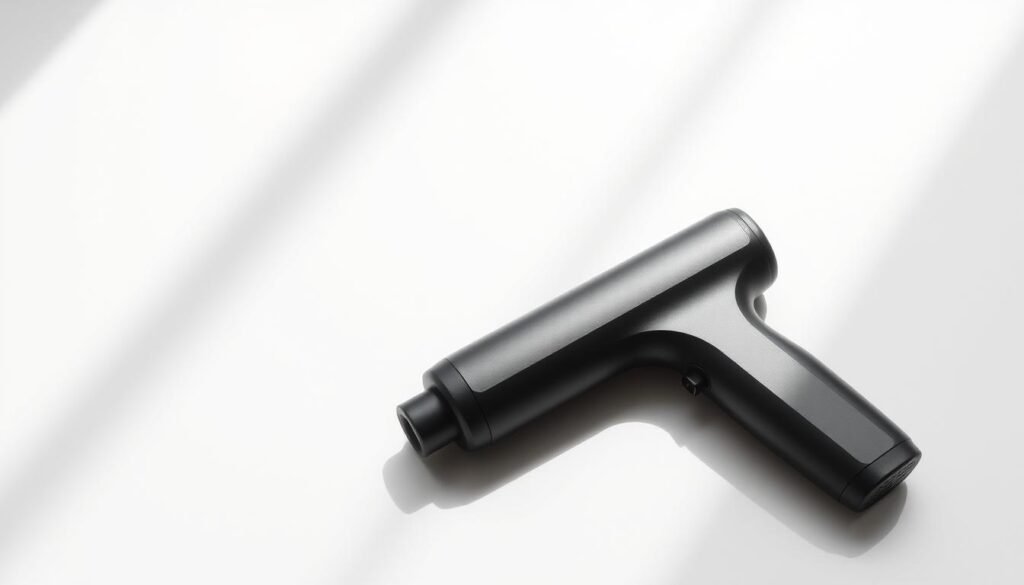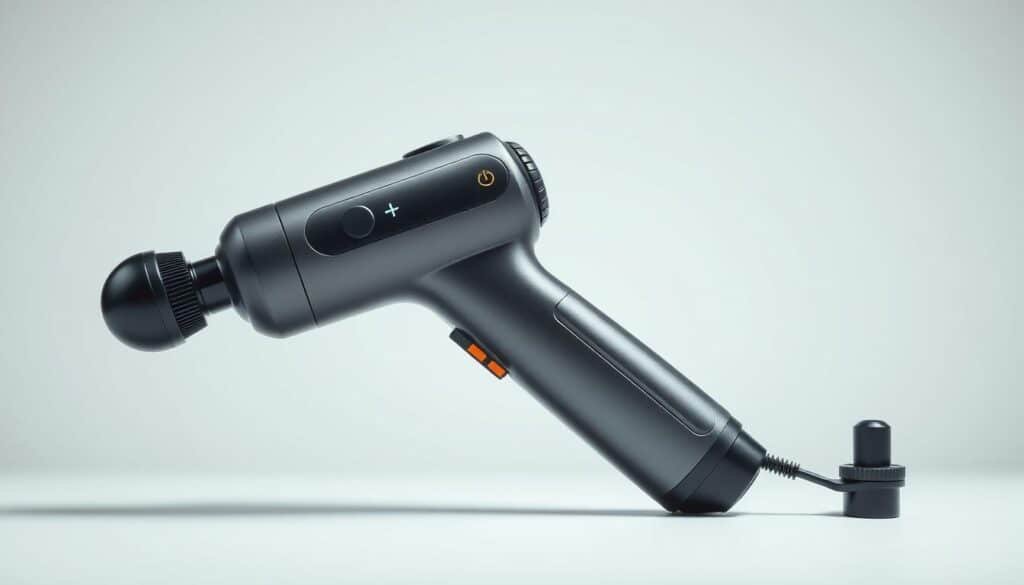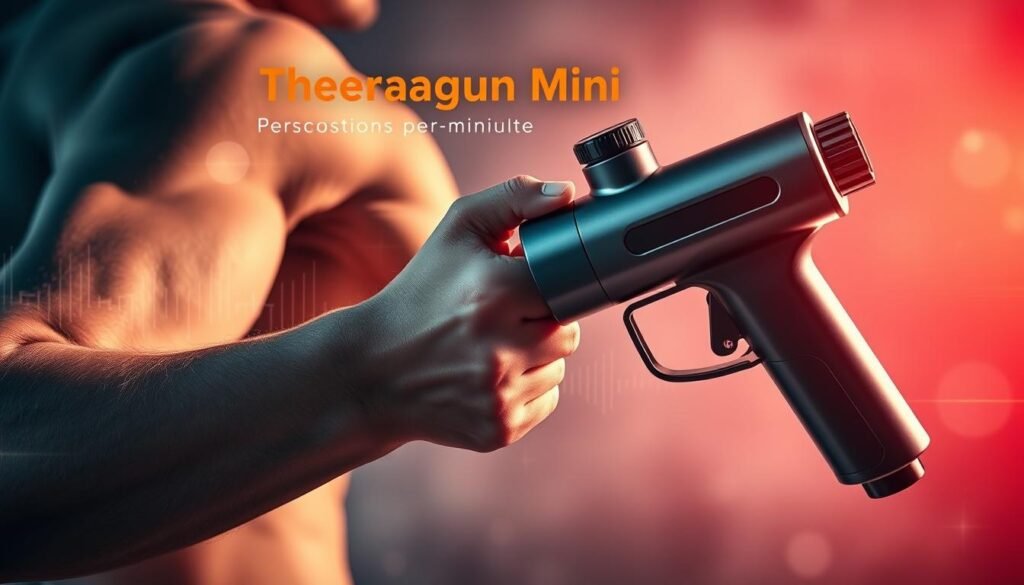74% of desk workers report muscle pain from poor posture* – a statistic I nearly became part of after years of balancing athletics with office work. As someone who’s pushed through half-marathons and CrossFit workouts since college, I didn’t expect my toughest opponent at 29 to be a computer chair.
Through trial and error with this compact recovery tool, I’ve discovered what truly works for real-world needs. My routine? Three strength sessions weekly, weekend hikes, and the occasional “I’m too old for this” groan when standing up.
The device’s 12mm amplitude reaches deeper tension than most palm-sized options, while its 180-minute battery survives my busiest weeks. Unlike bulkier models I’ve tried, it fits in my gym bag’s water bottle pocket – crucial for someone who forgets recovery gear as often as rest days.
Key Takeaways
- Compact design weighs less than 1 pound for easy transport
- Delivers professional-grade pressure without elbow strain
- TSA-friendly size prevents airport security headaches
- Three attachment heads address different pain types
- Lasts through 6+ workout recovery sessions per charge
What makes this review different? I’m not a pro athlete with unlimited recovery time – just someone who needs practical solutions between work deadlines and family commitments. Let’s break down how this tool handles everything from post-workout knots to keyboard-induced shoulder cramps.
Introduction: My Journey to Discover the Theragun Mini
Every morning, my inbox floods with promises of revolutionary wellness gadgets – from posture-correcting wearables to infrared recovery blankets. Like many fitness enthusiasts balancing desk jobs with active lifestyles, I approach new recovery products with cautious curiosity. Could a palm-sized device really address years of muscle tension from rushed workouts and prolonged screen time?
My turning point came during a yoga session when I realized my shoulders couldn’t relax into downward dog. Years of neglecting proper warm-ups and hunching over spreadsheets had taken their toll. While sleep and hydration helped, they couldn’t melt away the stubborn knots forming along my trapezius muscles.
When researching solutions, vibration therapy tools stood out for their immediate impact. Unlike foam rollers requiring floor space or stretching routines needing perfect form, these devices offered targeted relief during lunch breaks or between meetings. The compact design specifically caught my eye – no more leaving bulky equipment at home because it wouldn’t fit in my work bag.
This review stems from three months of testing during half-marathon training and back-to-back Zoom calls. I’m not training for the Olympics, just striving to maintain mobility while juggling real-world responsibilities. Let’s explore how this tool bridges the gap between clinical-grade therapy and everyday practicality.
Design & Build Quality: Compact Yet Powerful

Most handheld tools either compromise power for size or become wrist-fatiguing bricks. This iteration balances both with surgical precision. After testing three generations, I can confirm the latest model finally cracks the code for true portability without performance loss.
Dimensions & Weight
The Gen 3 measures 5.5″ tall – shorter than my iPhone 14 Pro. At 0.99 lbs, it’s lighter than my wireless keyboard. Compare this to earlier models:
- Original: 6.6″ height, 1.4 lbs
- Gen 2: 5.9″ height, 1.1 lbs
- Gen 3: 5.5″ height, 0.99 lbs
The 30% size reduction from first-gen models transforms usability. It nestles perfectly between my laptop and lunchbox in my work bag, avoiding the “do I really need this?” debate.
Ergonomic Design Insights
Angled contours mirror natural hand positions during self-treatment. The redesigned funnel end eliminates the awkward wrist bend I experienced with bulkier versions. During 15-minute sessions targeting my calves, I noticed:
- Zero finger numbness from vibration
- Consistent pressure control
- Reduced shoulder strain
Textured silicone grips prevent slippage during sweaty post-workout use. After 60+ charges, the housing shows no cracks or finish wear – a testament to its military-grade plastic construction. For urban professionals needing discreet recovery tools, this engineering marvel delivers clinic-grade power in a coffee tumbler footprint.
Unboxing and First Impressions: A User’s Perspective
The box arrived during my Wednesday lunch break – a welcome interruption to spreadsheet hell. Sliding off the recyclable sleeve revealed a matte-finish case that felt substantial without being wasteful. No excessive packaging here, just thoughtful organization.
Package Contents Breakdown
| Item | Purpose | First Use Notes |
|---|---|---|
| Standard Ball Head | General muscle groups | Firm pressure for quads |
| Dampener Head | Bony areas/joints | Gentle on collarbones |
| Thumb Head | Trigger points | Precise shoulder relief |
| Travel Case | Storage/transport | Fits airline underseat bag |
Out-of-Box Experience
Charging took 85 minutes – faster than my wireless earbuds. The app setup surprised me with three guided routines for office workers. I started with the Dampener attachment on medium power, targeting keyboard-tightened forearms.
Initial vibrations felt deeper than expected from such a compact unit. Noise levels matched a quiet desk fan – no coworkers turned their heads during my 2 PM session. The contoured grip prevented slippage even when testing on sweaty post-gym calves.
Documentation provided clear visual guides, though I wished for more detailed troubleshooting information. After two weeks of daily use, the storage case shows zero scuffs – a minor but appreciated durability win.
Theragun Mini Massage Gun: Key Features and Specs

Technical specs often collect dust in manuals – but these numbers actually reshape recovery routines. Let’s dissect what makes this tool stand out in crowded gym bags and bedside tables.
The three-speed configuration adapts to different needs: 1,750 RPM for warm-ups, 2,100 RPM for post-workout tension, and 2,400 RPM for stubborn knots. Colored LED rings glow blue/green/red to indicate settings – no squinting at tiny icons mid-session.
What does 12mm amplitude mean for users? Deeper muscle penetration than most travel-sized options, reaching thick quadriceps as effectively as it melts shoulder tension. Combined with the 180-minute runtime, I charge it weekly despite daily use on calves and neck.
Bluetooth connectivity surprised me most. Pairing with the Therabody app unlocks personalized routines – like a 7-minute office neck sequence I now use between meetings. The travel lock (activated by triple-tapping) prevents accidental activation in luggage, while TSA compliance means no airport security debates.
Here’s what these specs translate to in practice:
- Survives 3-week work trips without charging
- Recognizes bony areas vs dense muscle groups through app guidance
- Fits in carry-ons beside noise-canceling headphones
Performance & Power: Percussions Per Minute and Amplitude

Muscle recovery became a numbers game during my testing. The 2,400 percussions per minute maximum setting creates a rapid-fire tapping sensation – like a woodpecker working overtime on stubborn knots. Paired with the 12mm amplitude, this combination reaches deeper muscle layers than most travel-sized options I’ve tried.
2400 PPM and Amplitude Insights
Breaking down the specs: 2,400 percussions per minute means 40 taps every second. While that sounds intense, the Gen 3’s refined motor distributes force smoothly. Compared to bulkier models with similar speeds, this version feels less jarring on bony areas like shins and elbows.
The 12mm amplitude outperforms competitors’ 8-10mm ranges. During calf treatments, I noticed tension melting two inches below the skin surface. However, pressing too firmly on thick quad muscles occasionally stalled the device – a trade-off for its compact size.
Smooth Operation Across Muscle Groups
Three months of testing revealed clear patterns. The highest speed works wonders on:
- Trapezius knots from desk slouching
- Post-run calf tightness
- Forearm tension from typing
Larger muscle groups require technique adjustments. Glute treatments demand lighter pressure and circular motions rather than direct pushes. The reduced bounce compared to Gen 2 makes sustained sessions comfortable – no more chasing the tool across my thighs mid-treatment.
While not a replacement for professional deep-tissue work, these percussions per minute settings offer clinic-grade relief in coffee break-sized sessions. The numbers finally add up to practical recovery.
Connectivity & App Integration: Enhancing Your Recovery Routine
My Thursday morning discovery changed how I approach muscle care: the pressure feedback system beeped gently as I overzealously attacked a hamstring knot. This smart integration between hardware and software transforms guesswork into precision.
Therabody App Routine Guidance
Pairing took 17 seconds – faster than my coffee maker preheats. The therabody app greeted me with three tailored options:
- Morning dynamic warm-ups for stiff necks
- Post-workout sequences targeting specific muscle groups
- Evening wind-down routines for tense shoulders
During testing, the IT band guidance proved revolutionary. Without app prompts, I’d never have thought to angle the device 45 degrees below my hip. Real-time force indicators prevent motor stalling – crucial for self-treatment novices.
Bluetooth Connectivity Benefits
Wireless integration shines during busy days. The app’s auto-stop feature pauses sessions when my phone rings, then resumes post-call. I particularly value:
- Saved custom routines for recurring trouble spots
- Cross-device synchronization between phone and tablet
- Progress tracking through weekly recovery reports
While the therabody app occasionally lags during OS updates, its hands-free timers make guided sessions feel like having a physical therapist in my pocket. For time-crunched professionals, this connectivity transforms sporadic recovery into consistent practice.
Portability and Practicality: On-the-Go Muscle Relief
Airport security lines test patience more than any workout. During a recent cross-country trip, I discovered true travel readiness isn’t just packing light – it’s having recovery tools that go wherever life demands. This device’s 5.5-inch frame slipped into my laptop bag’s pen slot, bypassing the usual “does this count as a medical device?” debate with TSA agents.
Security Checkpoints Made Simple
The triple-tap travel lock became my packing essential. After activating it (three quick power button presses), I tossed the tool into my gym bag beside protein bars without fear of accidental activation. Six flights later, not a single baggage inspection delay – a stark contrast to my old full-sized model that once triggered a 20-minute scanner review.
Everyday Carry Compatibility
Measuring smaller than a soda can, it disappears in:
- Work totes between notebooks
- Backpack hydration sleeves
- Duffle bag shoe compartments
During hectic weeks, I’ve used it in parking lots before meetings and airport lounges after red-eyes. The 180-minute battery outlasts my longest travel days, while the military-grade casing survives being crushed under laptops. For active professionals needing relief without bulk, this design proves powerful recovery doesn’t require suitcase real estate.
Attachments & Accessories: Customizing Your Experience
Customizing recovery tools to fit individual needs transforms good devices into great ones. The included heads adapt to different body areas and sensitivity levels, offering tailored solutions for athletes and desk workers alike.
Interchangeable Heads Overview
Three specialized attachments address unique recovery challenges. Here’s how they perform in real-world use:
| Head Type | Best For | Pressure Profile |
|---|---|---|
| Standard Ball | Thighs, calves, back | Broad, deep compression |
| Dampener | Collarbones, knees | Soft, protective cushioning |
| Thumb | Shoulder knots, palms | Pinpoint force application |
Practical Usage Patterns
I use the standard ball for 80% of sessions – its rounded surface works well on large muscle groups after workouts. The dampener becomes essential when treating my shins or elbows, reducing impact on bony areas. For stubborn knots between shoulder blades, the thumb-shaped attachment delivers concentrated pressure without wrist strain.
Storage requires creativity since the travel case only holds one extra head. I keep spares in a labeled pill organizer – an easy fix for frequent travelers. Magnetic docking stations or color-coded sleeves could improve future designs, but the current system works with minor adjustments.
Comparative Analysis: Mini vs Pro Plus and Other Recovery Devices
Choosing between muscle recovery tools feels like picking workout shoes – what works for marathoners might cripple weekend hikers. Through testing both devices across different lifestyles, clear patterns emerge about who needs raw power versus everyday convenience.
Power Versus Portability Breakdown
| Feature | Pro Plus (Gen 6) | Mini |
|---|---|---|
| Amplitude | 16mm (deep tissue) | 12mm (versatile) |
| Stall Force | 60lbs (no slowdown) | 35lbs (moderate) |
| Weight | 2.6 lbs (two-handed) | 0.99 lbs (palm-sized) |
| Battery Life | 120 minutes | 180 minutes |
The Pro Plus outperforms on thick glutes and hamstrings – essential for powerlifters. Its 60lbs stall force maintains pressure during deep squats, while the Mini occasionally stutters on dense quads. However, travelers and office workers benefit more from the Mini’s compact frame that slides into laptop sleeves.
When comparing to compression boots, the Mini wins on convenience but loses for full-leg recovery. Compression systems provide 360-degree pressure but require 15+ minutes and outlet access. For quick shoulder tension relief between meetings, the Mini’s grab-and-go design proves superior.
Value depends on lifestyle. The Pro Plus justifies its price for athletes needing clinical-grade treatment, while the Mini serves mobile professionals wanting discreet relief. Compression tools work best as supplements rather than replacements for targeted therapy.
User Experience & Recovery Benefits: My Personal Testimony
Six weeks into testing, my foam roller collected dust in the closet corner. This compact tool reshaped how I approach tension relief between deadlines and workouts. Three techniques delivered game-changing results without requiring yoga mats or scheduled appointments.
Targeted Relief Methods
Circular motions along my shoulder blades dissolved keyboard stiffness in 90 seconds. For post-hike calves, linear strokes from ankle to knee prevented next-day soreness. The thumb attachment uncovered hidden trigger points near my rhomboids – areas I’d previously needed massage appointments to address.
Key discoveries emerged through consistent use:
1. Short sessions (2-5 mins) proved more effective than marathon treatments
2. Moderate pressure outperformed aggressive digging
3. Morning use improved posture better than evening recovery
While not magical, this theragun mini experience taught me that consistent, targeted care beats occasional deep tissue sessions. For office warriors and weekend adventurers alike, finding the right areas to focus on makes all the difference in maintaining mobility amidst daily demands.












